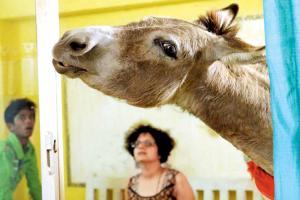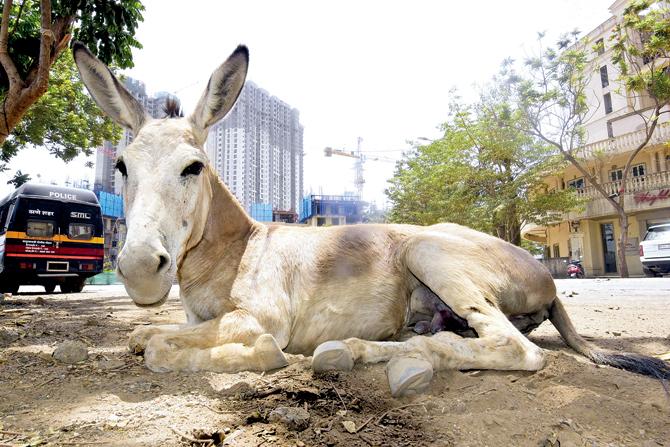Thanks to four-wheels, we no longer need these beasts of burden that once dotted every construction site and plodded along loyally with the dhobi. But, there are a few humans working to ensure that the gadha is not forgotten

Sharmila Sankar on the set of Pyari Dulhan with her donkey
Last year, Dr Dattatrya Shripati Kate, an Aurangabad-based engineer, presented a research paper titled 'A study on the history and utility of donkeys' at an international conference in London. "In all probability, I may be the only Indian to have done so," says the 55-year-old. The inspiration to present a case for the donkey came from a humdrum moment when he was outside his residence one morning. "I saw a lady selling jenny (term for a female donkey) milk. It took me back to my childhood in rural Maharashtra, where donkeys were bred in plenty. It was believed - and still is - that jenny milk is a good preventive for asthma and respiratory problems, and is equal to breast milk in terms of nutrients," says Kate over a phone call from Aurangabad. What made his resolve stronger was that it was after donkey's years that he had spotted one. "You just don't see them anymore. So, I wanted to highlight the fact that they irreplaceable."
ADVERTISEMENT

Donkey settlements can be found in Thane, Bhiwandi and Vasai. Rearing the animal has traditionally been a business in the Waradi community. Pic/Sameer Markande
Industrial revolution yet again
Kate is not alone in his observation that the animal is gradually disappearing from public consciousness. Data shared by the Maharashtra State Animal Husbandry Department supports his claim. Earlier this month, the body sent a circular to all district collectors warning them of the dwindling donkey population, asking them to take preventive measures. The circular adds that if the trend is not reversed, we might lose them forever. But, it's not just us. The homepage of UK-based non-profit Donkey Sanctuary, states that while 50 million donkeys and mules exist in the world, several are on the verge of extinction.
In the home turf, the enormity of the situation is only beginning to dawn. The signs are visible. Kate, for instance, had to undertake trips to Madhi, a village in Pathardi taluka, Ahmednagar, to find donkeys because they barely have a presence in urban areas. In his paper, he points out that there are 185 subtypes of donkeys and the count is approximately four crores worldwide. Surprisingly, 96 per cent of the count is concentrated in underdeveloped countries. "That's because they are working equids and extremely hardy," says Dr Kshama Shirodkar, veterinary officer at Thane Municipal Corporation. In the interiors of Thane, donkeys are still spotted lugging debris and pulling carts up narrow terrains where it would be difficult to take a vehicle. "Settlements are slowly giving way to highrises. So, due to rapid industrialisation and mechanisation, the services of a donkey are rendered useless," she points out. Breeding donkeys, therefore, becomes unviable. In fact, last year, four donkeys in Thane were sent to a gaushala because the owners couldn't sustain the costs of caring for the animal. According to Shirodkar, every donkey has a owner, given the fact that rearing them was traditionally a family business of Waradis, a community that dealt in donkey trade.

Dr DS Kate, an Aurangabad-based engineer, presented a research paper titled 'A study on the history and utility of donkeys' at a conference in London
A real smart a**
According to the Animal Census of 2012 (the latest survey available), there were 29,135 donkeys in Maharashtra, a fall of over nine per cent from 32,070 in 2007. As per the International Union for Conservation of Nature, an endangered species is one that meets any one of the following criteria: a 50–70 per cent population decrease over 10 years, a population size less than 2,500 adults, or a statistical prediction that it will go extinct within the next 20 years. Disturbing statistics coupled with general apathy towards donkeys, propelled independent filmmaker Sharmila Sankar to make Pyaari Dulhan, a short film on donkeys in 2016. The film was aimed at subverting the incorrect, but popular narrative that donkeys are dumb. "They are impassive, because they don't respond as a horse or a dog would, so it's easy to assume that they are not understanding what you are saying. Fact is that they are good learners, and extremely affectionate," she says. During the making of the film, Shankar had bought two donkeys, Pyara and Pyari, in Kalwa. "Because they are extremely overworked, they die fast. While their lifespan is 12 to 14 years, rarely do they live beyond seven years," she says.
If they don't live up to their stipulated lifespan, road accidents are a factor to blame. Shakuntala Majumdar, president of The Thane Society for the Prevention of Cruelty to Animals (TSPCA) remembers the time when she was at her wits' end dealing with donkey accident cases. "I was inundated with these calls, because owners wouldn't accompany the donkeys. It came to a point where I felt we had to find a way out," she says. That's when Majumdar, along with Shirodkar, decided to reach out to donkey owners and sensitise them. "The owners are now well-regulated and their names are registered with us," she says. Like Sankar, whose donkeys were adopted and sent to a farm in Pali, Majumdar has been working towards finding forever homes for donkeys.
Last December, she lost Dear, the lone resident donkey with a missing leg at TSPCA, after nine years. Dear was a baby when a road accident left him disabled. "He was the star of the place for his antics with his prosthetic leg, and his friendship with Shembur, the resident cat who he would carry on his back," she says.
Catch up on all the latest Mumbai news, crime news, current affairs, and also a complete guide on Mumbai from food to things to do and events across the city here. Also download the new mid-day Android and iOS apps to get latest updates
 Subscribe today by clicking the link and stay updated with the latest news!" Click here!
Subscribe today by clicking the link and stay updated with the latest news!" Click here!






